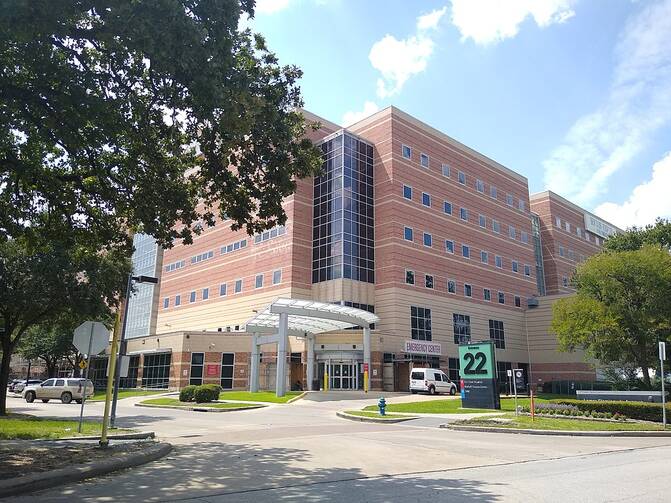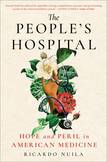Review: How can we fix our hospitals?
Hospitals used to be for people: the sick and those able to care for the sick. We built hospitals from a vision of charity—the need to encounter a person at their most vulnerable—as places for all, irrespective of their ability to pay. It is why medicine was once a calling.
Hospitals in the United States today are for profit: their investors and the executives able to run sprawling health systems. We now build these hospitals with a view to productivity—the need to concentrate ill people who need lucrative interventions—as places of high-tech care for those who can afford it. It is why health care is now a consumer good.
In his debut book, The People’s Hospital: Hope and Peril in American Medicine, Ricardo Nuila calls today’s $4.3 trillion dollar health care industry “Medicine Inc.” He laments that it “isn’t working, not for medicine or patients,” and that in the name of profit it has “usurped this beautiful combination of art and science that doctors and nurses practice.” Nuila presents the conflict between the profit motive of health care and the art of medicine by describing the hospitals that work for people and the hospitals that do not.
Nuila counts himself blessed, writing that it is at public hospitals that a physician can find his calling, his good work, his vocation.
The hospitals that deny care to the indigent ill are the ones that do not work. These hospitals “dump” patients “at critical moments, when immediate medical intervention can mean the difference between life and death.” Nuila describes case after case where a patient is denied a test, a medication or a procedure by these hospitals because there is insufficient profit in providing care. Those hospitals are spreading throughout our nation in expansive Medicine Inc. systems.
The hospitals that work are general hospitals, caring for patients with a range of medical conditions, but also safety net hospitals, preferentially serving the varieties of marginalized ill people. Practically every city used to have a hospital that worked. Over the last 50 years, their number gradually decreased. Cleveland closed Saint Vincent’s, Los Angeles lost Martin Luther King Jr., and New Orleans abandoned Charity. In the last five years, we lost another 70.
Nuila works at one of the survivors, Ben Taub Hospital in Houston. Nuila grew up in Houston, the son of Salvadoran immigrants, and returned home for medical training. He studied in Ben Taub’s operating rooms as a medical student and trained in its wards as a resident, and is now attending throughout the hospital as a practicing internist.
Ben Taub Hospital serves one of the largest cities—Nuila reminds readers that the landmass of metro Houston exceeds the area of the state of New Jersey—in the most prosperous country in the world. Ben Taub sits within the Texas Medical Center, which bills itself as a “visionary global medical complex.” Ten million patients are cared for annually in its 9,200 beds in facilities spread over 50 million square feet. But most of the beds and most of those services are closed to the patients Nuila meets at Ben Taub, because his patients are the “un”: the uninsured, the undocumented, the unhoused, the unhinged and the undesirable.
If you read a history of one of today’s gleaming specialty hospitals or multi-state health systems, it’s usually heavily vetted by a PR department.
Medicine Inc. hospitals literally do not work for these un-patients. As a result, Nuila writes, they do not work for the rest of us. Nuila relates stories of people who fall out of their health insurance, leaving them to choose between their health and basic needs like food and shelter. Abandoned by the health care system, they start GoFundMe pages to pay for prostheses until they find their way to the people’s hospital.
Ben Taub is a 402-bed hospital affiliated with 16 neighborhood health centers. Staffed by faculty and resident physicians from Baylor University, Ben Taub provides primary care, specialty care and emergency services. It does so because of a commitment by the people of Houston, which supports Ben Taub with millions of dollars in property taxes. In return, Ben Taub provides services that are inaccessible to people in many parts of Texas. It is a people’s hospital, for those blessed to have it.
Nuila counts himself blessed, writing that it is at public hospitals that a physician can find his calling, his good work, his vocation. After all, he admits to a patient, “I went to Catholic school all my life.” That was a local Jesuit high school before Georgetown University, and it is perhaps that training that led him to structure the book as a cycle of stories and arguments, almost like the pattern of proclaiming a reading and then explaining it in a homily. It can leave a reader with similar catechetical training waiting a little bit for the next movement, when bread becomes body.
Nuila writes that a transformation in health care could happen if governments across the country supported safety-net hospitals like Ben Taub. That answer feels necessary but insufficient, leaving out a reflection on how you turn Americans into a people capable of acts of solidarity and subsidiarity like a local public hospital.
Nuila seems to sense this and, as he brings the book to its conclusion, searches for a different kind of ending. In the final chapter, he tells of his encounters with a devout Muslim patient. She is a woman of deep faith. Nuila reflects that his faith has broadened since his youth. She worships God. Nuila admits he is no longer able to assign a name to his faith but honors the behavior of faith. That habit of believing in people who choose to care for other people gets Nuila to his conclusion. “That’s what healthcare is at its best, what I see at Ben Taub: science coming together with people. It’s why I continue to believe in medicine. My faith comes full circle when I imagine myself through each of their eyes and I realize I’m one of them.”
Perhaps we write about public hospitals to reinforce our memories of what hospitals once were.
The personal encounter, the realization of a shared humanity; it is the faith of a true physician. It is also why, as Nuila writes, “Faith will always be a part of practicing medicine.”
One measure of the endurance of faith can be found in books published about medicine. People’s hospitals are rare these days but remain popular among publishers. Perhaps it is hard to sell a book about Medicine Inc.’s health care factories. If you read a history of one of today’s gleaming specialty hospitals or multi-state health systems, it’s usually heavily vetted by a PR department. The audience is the medical staff and the philanthropic class. Perhaps publishers suspect the rest of us would recoil at the stories of hospital executives dining out on their profits while their patients starve.
Publishers typically serve up stories of the hospital that works. Just in the last few years, David Oshinky’s Bellevue told in detail the history of New York City’s most famous hospital while charting our nation’s shifting account of what the indigent ill deserve. David Ansell’s County related personal stories of training and teaching at Cook County Hospital in Chicago. Mike King’s A Spirit of Charity, focusing on Grady Hospital in Atlanta described the public policies that have alternately enabled and crippled public hospitals.
Perhaps we write about public hospitals to reinforce our memories of what hospitals once were. Perhaps those memories still haunt us, that idea of a hospitable place that will take us in when we are ill. Of all these books, Nuila’s seems most poised to reanimate the ghost of the public hospital. He knows his history as well as Oshinsky, his story as well as Ansell and his policy as well as King. But Nuila is the best writer of them all, able to narrate the experience of being ill and caring for the ill to make his readers feel that they too now know that the people’s hospital is “one of the world’s little secrets.” And it might become so widely shared that it is no longer a secret.
This article also appeared in print, under the headline “Alternative Medicine,” in the October 2023, issue.











